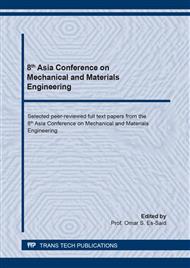[1]
R. Geyer, et al.: Production, use, and fate of all plastics ever made, Science Advances, Vol. 3/1700782 (2017), pp.1-5.
Google Scholar
[2]
J.R. Jambeck, et al.: Plastic waste inputs from land into the ocean, Science, Vol. 347/6223 (2015), pp.768-771.
DOI: 10.1126/science.1260352
Google Scholar
[3]
S. Vinodh, et al.: Integrated Fuzzy AHP-TOPSIS for selecting the best plastic recycling method: A case study, Applied Mathematical Modelling, Vol. 38 (2014), pp.4662-4672.
DOI: 10.1016/j.apm.2014.03.007
Google Scholar
[4]
V. Goodship. Introduction to Plastics Recycling. Second Edition. Smithers Rapra, UK, (2007).
Google Scholar
[5]
S.M. Al-Salem, et al: Recycling and recovery routes of plastic sold waste (PSW): A review, Waste Management, Vol. 29 (2009), pp.2625-2643.
DOI: 10.1016/j.wasman.2009.06.004
Google Scholar
[6]
K. Hamad, et al.: Recycling of waste from polymer materials: An overview of the recent works. Polymer Degradation and Stability, Vol. 98 (2013), pp.2801-2812.
DOI: 10.1016/j.polymdegradstab.2013.09.025
Google Scholar
[7]
R.D. Deanin: Plastic additives, in C. Harper (Ed.). Handbook of Plastics Technologies, McGraw-Hill, New York, (2006).
Google Scholar
[8]
M.M. Raj et al.: Studies on mechanical properties of recycled polypropylene blended with virgin polypropylene, International Journal of Science Inventions Today, Vol. 2/3 (2013), pp.194-203.
Google Scholar
[9]
N.M Mehat and S. Kamaruddin. Optimization of mechanical properties of recycled plastic products via optimal processing parameters using the Taguchi method, Journal of Materials Processing Technology, Vol. 211 (2011), pp.1989-1994.
DOI: 10.1016/j.jmatprotec.2011.06.014
Google Scholar
[10]
L. Yu, et al.: Mechanical properties and long-term durability of recycled polysufone plastic, Waste Management, Vol. 84 (2019), pp.402-412.
DOI: 10.1016/j.wasman.2018.11.025
Google Scholar
[11]
S.K. Satya and P.S.R. Sreekanth: An experimental study on recycled polypropylene and high-density polyethylene and evaluation of their mechanical properties, Material Today: Proceedings (2020),.
DOI: 10.1016/j.matpr.2020.01.259
Google Scholar
[12]
K. Ragaert, et al.: Mechanical and chemical recycling of solid plastic waste, Waste Management (2017),.
Google Scholar
[13]
D.S. Gabriel: How to increase plastic waste acceptance for mechanical recycling: An introduction to material value conservation and its phenomenon, Key Engineering Materials, Vol. 705 (2016), pp.362-367.
DOI: 10.4028/www.scientific.net/kem.705.362
Google Scholar
[14]
A. Sangroniz, et al.: Packaging materials with desired mechanical and barrier properties and full chemical recyclability, Nature Communications, Vol. 10/3559 (2019), pp.1-7.
DOI: 10.1038/s41467-019-11525-x
Google Scholar
[15]
P.L. Martin: Testing of Materials, In C.A. Harper (Ed.). Handbook of Materials for Product Design, Third Edition, McGraw-Hill, New York, (2001).
Google Scholar
[16]
H. Dahlbo, et al.: Recycling potential of post-consumer plastic packaging waste in Finland, Waste Management, Vol. 71 (2018), pp.52-61.
DOI: 10.1016/j.wasman.2017.10.033
Google Scholar
[17]
M.K. Eriksen, et al.: Closing the loop for PET, PE, and PP waste from household: Influence of material properties and product design for plastic recycling, Waste Management, Vol. 96 (2019), pp.75-85.
DOI: 10.1016/j.wasman.2019.07.005
Google Scholar
[18]
R.Q. Assis, et al.: Biodegradable packaging of cellulose acetate incoporated with norbixin, lycopene or zeaxanthin, Industrial Crops & Products, Vol. 147 (2020), 112212.
DOI: 10.1016/j.indcrop.2020.112212
Google Scholar
[19]
B. Bideau, et al.: Nanocellulose-polypyrrole-coated paperboard for food packaging application, Progress in Organic Coatings, Vol. 123 (2018), pp.128-133.
DOI: 10.1016/j.porgcoat.2018.07.003
Google Scholar
[20]
D.S. Gabriel and J. Maulana: Impact of plastic labelling, coloring and printing on material value conservation in the products of secondary recycling, Key Engineering Materials, Vol. 733 (2018), pp.384-389.
DOI: 10.4028/www.scientific.net/kem.773.384
Google Scholar
[21]
M.R. Borman, et al.: Impact of plastic packaging design on the sustainability of plastic recyclers, International Journal of Applied Science and Engineering, Vol. 16 (2019), pp.25-33.
Google Scholar
[22]
R. Nurcahyo, et al.: Repetitive implementation of material value conservation and its effects on the mechanical properties of plastic recycling products. Materials Science Forum, Vol. 936 (2018), 116-120.
DOI: 10.4028/www.scientific.net/msf.936.116
Google Scholar
[23]
N.M. Mehat, et al: Multiple reprocessing of gear using recycled polypropylene, Applied Mechanics and Materials, Vol. 660 (2014), pp.204-208.
DOI: 10.4028/www.scientific.net/amm.660.204
Google Scholar
[24]
K. Wang, et al: Analysis of thermomechanical reprocessing effects on polypropylene/ethylene octene copolymer blends. Polymer Degradation and Stability, Vol. 97 (2012), 1475-1484.
DOI: 10.1016/j.polymdegradstab.2012.05.005
Google Scholar
[25]
Information on http://www.astm.org/.
Google Scholar
[26]
F. Gu, et al: Improvement of mechanical properties of recycled plastic blends via optimizing processing parameters using the Taguchi method and principal component analysis, Materials and Design, Vol. 62 (2014), pp.189-198.
DOI: 10.1016/j.matdes.2014.05.013
Google Scholar
[27]
C. Meran, et al.: Examination of the possibility of recycling and utilizing recycled polyethylene and polypropylene, Materials and Design, Vol. 29 (2008), pp.701-705.
DOI: 10.1016/j.matdes.2007.02.007
Google Scholar
[28]
A. Jansson, et al.: Degradation of post-consumer polypropylene materials exposed to simulated recycling--mechanical properties, Polymer Degradation and Stability, Vol. 82 (2003), pp.37-46.
DOI: 10.1016/s0141-3910(03)00160-5
Google Scholar
[29]
A. Oromiehie and A. Mamizadeh: Recycling PET beverage bottles and improving properties, Polymer International, Vol. 53 (2004), pp.728-732.
DOI: 10.1002/pi.1389
Google Scholar
[30]
J. Aurrekoetxea, et al.: Effects of recycling on the microstructure and the mechanical properties of isotactic polypropylene, Journal of Materieal Science, Vol. 36 (2001), pp.2607-2613.
Google Scholar
[31]
E. Matei, et al.: Recycled polypropylene improved with thermoplastic elastomers, International Journal of Polymer Science, (2017), 7525923.
Google Scholar
[32]
H.S. Tai and J.L Yeh: Evaluation and verification of the virgin-recycled mixing ratio of polypropylene plastic, Journal of the Chinese Institute of Engineers (2018),.
DOI: 10.1080/02533839.2017.1419074
Google Scholar
[33]
J.N. Hahladakis, et al: An overview of chemical additives present in plastics: Migration, release, fate and environmental impact during their use, disposal, and recycling, Journal of Hazardous Materials, Vol. 344 (2018), pp.179-199.
DOI: 10.1016/j.jhazmat.2017.10.014
Google Scholar


